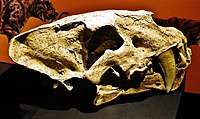Paramachairodus
Paramachairodus is an extinct genus of saber-tooth cat of the subfamily Machairodontinae, which was endemic to Europe and Asia during the late Miocene from 15 to 9 Ma.[2]
| Paramachairodus | |
|---|---|
| Scientific classification | |
| Kingdom: | Animalia |
| Phylum: | Chordata |
| Class: | Mammalia |
| Order: | Carnivora |
| Suborder: | Feliformia |
| Family: | Felidae |
| Subfamily: | †Machairodontinae |
| Tribe: | †Smilodontini |
| Genus: | †Paramachairodus Pilgrim, 1913 |
| Species | |
| |
| Synonyms | |
|
Paramachaerodus
P. orientalis
| |
Paramachairodus is one of the oldest known true saber-toothed cats. Many fossils were discovered in Cerro de los Batallones, a Late Miocene fossil site near Madrid, Spain. One leopard-sized species is known, Paramachairodus orientalis from the Turolian. A second species, Paramachairodus maximiliani, has been considered a synonym of Paramachairodus orientalis by some authors,[3] but was considered a valid species in the most recent systematic revision.[1] That revision, based on an extensive morphological analysis, also determined that the species P. ogygia exhibited less derived sabertooth features than the other Paramachairodus species and should be assigned to a separate genus, Promegantereon.[1][4] A third species, Paramachairodus transasiaticus, has recently been described based on analysis of new fossil material from the late Miocene localities of Hezheng, Gansu Province, China, and Hadjidimovo, Bulgaria. These specimens had sabertooth characteristics intermediate between those of P. ogygia and those of P. orientalis and P. maximiliani.[5]
The animals were about 58 centimetres (23 in) high at the shoulder, similar to a leopard, but with a more supple body. The shape of its limbs suggests that it may have been an agile climber, and could have hunted relatively large prey.[6]
References
- Salesa, M. J., Anton, M., Turner, A., Alcala, L., Montoya, P., & Morales, J. (2010). Systematic revision of the Late Miocene sabre‐toothed felid Paramachaerodus in Spain. Palaeontology, 53(6), 1369-1391.
- Paleobiology Database: Paramachairodus Basic info.
- SALESA, MANUEL J.; ANTON, MAURICIO; TURNER, ALAN; MORALES, JORGE (2005). "Aspects of the functional morphology in the cranial and cervical skeleton of the sabre-toothed cat Paramachairodus ogygia (Kaup, 1832) (Felidae, Machairodontinae) from the Late Miocene of Spain: implications for the origins of the machairodont killing bite". Zoological Journal of the Linnean Society. 144 (3): 363–377. doi:10.1111/j.1096-3642.2005.00174.x.
- Antón, Mauricio (2013). Sabertooth. Bloomington, Indiana: University of Indiana Press. ISBN 9780253010421.
- Li, Y.; Spassov, N. (2017). "A new species of Paramachaerodus (Mammalia, Carnivora, Felidae) from the late Miocene of China and Bulgaria, and revision of Promegantereon Kretzoi, 1938 and Paramachaerodus Pilgrim, 1913". PalZ. 91 (3): 409. doi:10.1007/s12542-017-0371-7.
- Turner, Alan (1997). The Big Cats and their fossil relatives. New York: Columbia University Press. p. 60. ISBN 978-0-231-10228-5.
